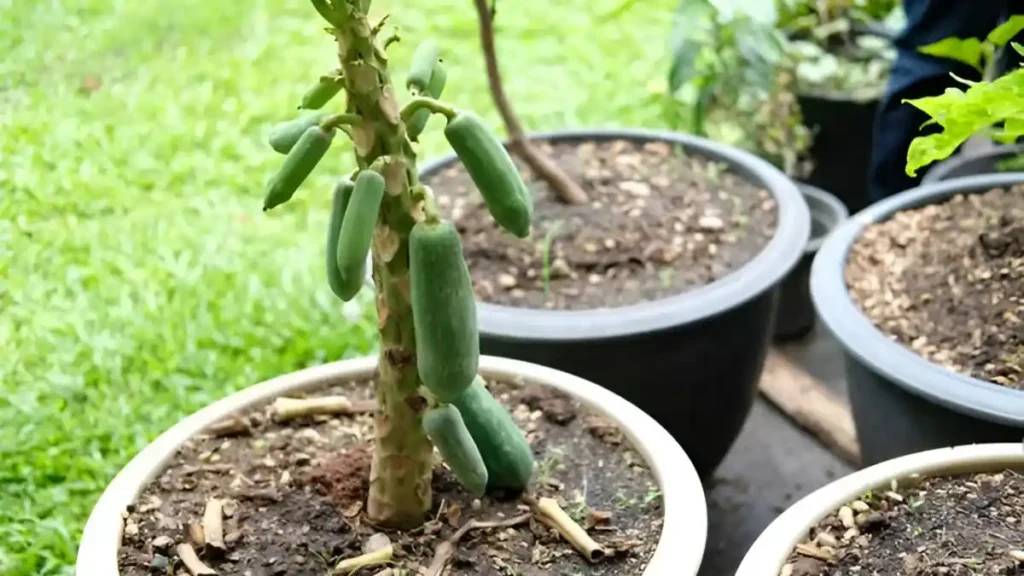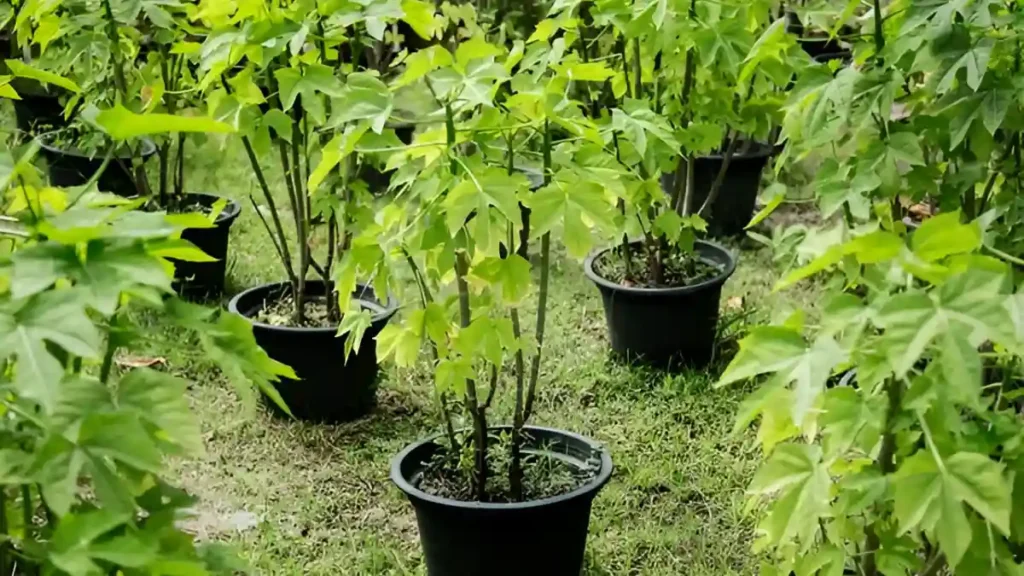Even if you don’t live in a warm area, growing papaya in indoor pots is a gratifying experience that lets you enjoy fresh, tropical fruit all year long. You may grow a healthy papaya plant in your own house provided it receives the proper attention and growing circumstances. This article will take you step-by-step through the fundamentals of how to grow papaya indoors, from choosing the best type and potting mix to creating the perfect atmosphere for your plant to thrive.
Here’s a comprehensive guide on how to grow papaya in pots from seeds:
- Not every variety of papaya can be grown indoors. Seek for dwarf or tiny cultivars, such as ‘Dwarf Hawaiian’ or ‘Solo,’ which are easier to handle and ideal for planting in containers.
- Select a large pot that drains effectively and has a minimum diameter of 18 to 24 inches. Because papaya trees have deep root systems, it is best to cultivate them in a tall pot. Make sure the pot has openings for drainage to avoid waterlogging, which can cause rot in the roots.
- Make use of an excellent, organic matter-enriched potting mix that drains well. Mixtures designed especially for tropical plants or a combination of compost, perlite, and peat moss are also effective. Maintaining proper drainage is essential to avoiding root infections. pH 6.0–7.0 slightly acidic soil is preferred by papayas above neutral soil.
- Start with a young nursery plant or papaya seeds. To expedite germination, if you’re using seeds, immerse them in water for 24 to 48 hours. Sow the seeds or move the young plant into the pot that has been prepared. Plant them around 1/2 inch into the ground. Usually, germination takes two to three weeks. Young papaya plants, if available, should be transplanted into the pot while making sure the root ball remains intact.

Indoor papaya plant care:
- For proper growth, papaya trees need lots of sunlight. Your pot should be placed where it will get at least 6 to 8 hours of direct sunlight per day. Put your plant next to a window that faces south. Consider adding grow lights as a supplement if natural light is inadequate.
- As tropical plants, papayas do best in warm weather, 70–90°F (21-32°C). Keep the inside temperature constant and keep the plant away from air conditioning or drafty areas. Use a humidity tray or spritz the plant frequently to maintain high humidity levels.
- Give the papaya plant plenty of water, letting the top inch of soil dry out in between applications. Because papayas are sensitive to being soggy, avoid overwatering them. Increase the frequency of watering throughout the growing season and decrease it during the cooler months.
- Throughout the growing season, give your papaya plant a balanced fertilizer that is soluble in water every two to four weeks. For fruit development, a potassium-rich fertilizer is advantageous. An NPK fertilizer of 10-10-10 is appropriate. Steer clear of overfertilizing, as this may cause the soil to accumulate salt. As growth slows down in the winter, cut back on feeding.
- Pruning your papaya plant regularly can help it keep its shape and get rid of any dead or yellowing leaves. Pruning also promotes healthy growth and fruit production by improving light and air penetration. The plant may require assistance to remain upright as it grows. To hold the plant steady, use a plant support ring or a stake.
- For indoor papaya trees to bear fruit, hand pollination may be necessary. To move pollen from the male flowers to the female blossoms, use a little brush. Fruit set depends on this procedure because indoor conditions may prevent insects from pollinating naturally.
Conclusion:
To sum up, learning how to grow papaya in pots may be a fruitful and rewarding project that produces tasty and healthy fruit even in small places. These instructions will help you grow papayas successfully in pots so you may eat fresh fruit that you’ve cultivated yourself. Your papaya plant’s health and productivity depend on regular maintenance and observation.
Certainly! If you’d like to learn more, please consider following our WhatsApp Channel: Harvest Gardening
A frequently asked questions:
Q1: How to grow papaya in pots with proper management of pests and diseases?
A1: Check the plant frequently for pests such as spider mites, whiteflies, and aphids. Apply neem oil or organic insecticidal soap as a therapy. To stop fungal infections, make sure there’s adequate air circulation and don’t overwater.
Q2: How do I propagate papaya plants?
A2: Typically, papayas are grown from seeds. Utilize the fresh papaya fruit seeds that are ripe. After cleaning and drying, place the seeds in a seed-starting mix that allows for good drainage. It takes two to three weeks for germination.
Q3: How long does it take for a papaya tree to bear fruit?
A3: In six to twelve months after planting, a papaya tree can begin to bear fruit under optimum circumstances.



